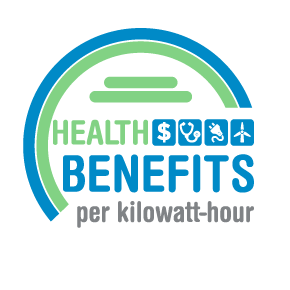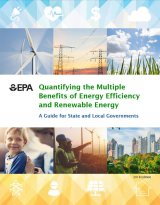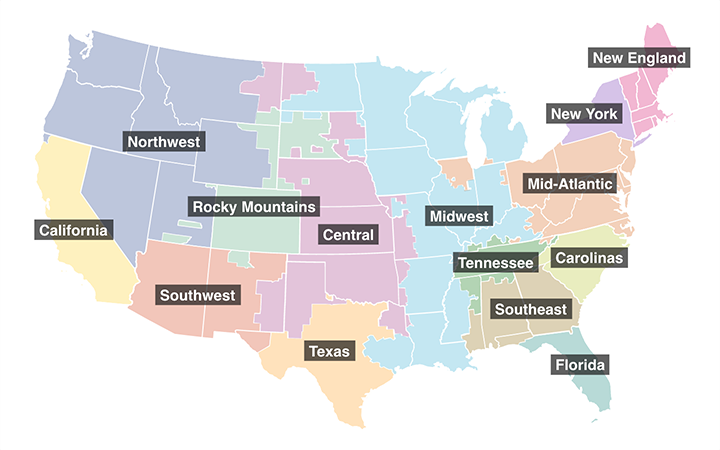Estimating the Health Benefits per Kilowatt-Hour of Energy Efficiency and Renewable Energy
 EPA has developed a set of values that helps state, local, and Tribal government policymakers and other stakeholders estimate the outdoor air-quality-related public health benefits of investments in energy efficiency, renewable energy, and solar photovoltaic, or PV, paired with energy storage (EE/RE/ES+). EPA developed these monetized values using the same methods it uses to analyze health benefits at the federal level. To learn more about the health effects included in the benefits-per-kilowatt-hour (BPK) calculations, please see the 2024 update of the technical report. For examples of how to use the BPK values, see this flyer.
EPA has developed a set of values that helps state, local, and Tribal government policymakers and other stakeholders estimate the outdoor air-quality-related public health benefits of investments in energy efficiency, renewable energy, and solar photovoltaic, or PV, paired with energy storage (EE/RE/ES+). EPA developed these monetized values using the same methods it uses to analyze health benefits at the federal level. To learn more about the health effects included in the benefits-per-kilowatt-hour (BPK) calculations, please see the 2024 update of the technical report. For examples of how to use the BPK values, see this flyer.
EPA used a peer-reviewed methodology to develop a set of screening-level regional estimates of the dollar benefits (in cents per kilowatt-hour) from the eight different types of EE/RE/ES+ initiatives listed below:

Uniform energy efficiency: Energy efficiency measures that achieve a constant level of savings over one year.

Energy efficiency at peak: Energy efficiency measures that achieve savings when energy demand is high (i.e., from noon to 8:00 p.m. on weekdays and non-federal holidays in June–September and from 6:00 a.m. to 9:00 p.m. on weekdays and non-federal holidays in October–May).

Distributed solar energy: Interventions that increase the supply of distributed solar energy available (e.g., rooftop solar generation).

Utility solar energy: Interventions that increase the supply of energy available from utility-scale solar.
![]()
Distributed PV-plus-storage: Interventions that increase the supply of energy available from paired distributed solar-plus-storage resources.
![]()
Utility PV-plus-storage: Interventions that increase the supply of energy available from paired utility-scale solar-plus-storage resources.

Onshore wind energy: Interventions that increase the supply of onshore wind available (e.g., wind turbines).

Offshore wind energy: Offshore wind energy: Interventions that increase the supply of offshore wind available (e.g., wind turbines).
Who might want to use these benefits-per-kWh screening values?
Stakeholders interested in approximating the monetized value of the outdoor air-quality-related public health benefits of EE/RE/ES+ may include:
- State, local, and Tribal energy, air quality, or public health agencies
- Public utility commissions
- Energy efficiency and renewable energy project developers
- Nongovernmental organizations
- Other researchers
See examples of publications that cite the BPK values.
When should the benefits-per-kWh values be used?
The BPK values are reasonable approximations of the monetized health benefits of state, local, and Tribal EE/RE/ES+ investments. Stakeholders can use them for preliminary analysis when comparing policy scenarios to indicate the direction and relative magnitude of impacts.
The following are examples of analyses where it would be appropriate to use the BPK values:
- Estimating the public health benefits of investments in EE/RE/ES+ projects, programs, and policies
- Understanding the cost-effectiveness of energy efficiency programs, projects, and policies
- Incorporating health benefits into short-term policy analyses and decision-making
See examples of how to use the BPK values.
When should benefits-per-kWh values not be used?
BPK values are not a substitute for sophisticated analysis and should not be used to justify or inform federal regulatory decisions. They are based on data inputs, assumptions, and methods that approximate the dynamics of energy, environment, and health interactions and include uncertainties and limitations, as documented in the technical report. While many of these health benefits are likely to accrue within the given region, the estimated health benefits are based on national-level modeling and are not appropriate for understanding localized impacts. To estimate subnational impacts, consider using the AVoided Emissions and geneRation Tool (AVERT), the CO-Benefits Risk Assessment Health Impacts Screening and Mapping Tool (COBRA), or another air quality modeling platform.
How can benefits-per-kWh values be used?
States, Tribes, and local communities interested in screening-level estimates of the outdoor air-quality-related health impacts of EE/RE/ES+ can multiply the BPK values by the number of kilowatt-hours saved from energy efficiency or generated from RE/ES+ to estimate potential health benefits from projects in dollars saved. See examples of how to use the BPK values. Users should note that EPA suggests that the values not be used to determine health benefits for more than five years before or after 2023.
BPK values are provided with up to four significant figures. EPA recommends that when these BPK values are multiplied by a kilowatt-hour intervention, the resulting dollar benefits are reported with two significant figures, in keeping with the reporting recommendations for the COBRA model.
EPA created BPK values using existing EPA tools, including EPA’s AVoided Emissions and geneRation Tool (AVERT) and CO-Benefits Risk Assessment (COBRA) Health Impacts Screening and Mapping Tool.
The BPK values:
- Are available for each of the eight project types for each of the 14 AVERT regions shown in the map below. If you don’t know your region, you can use the AVERT Web Edition to find a region based on your selected state and county.
- Are based on 2023 electricity generation data, and emissions, population, baseline mortality incidence rate, and income growth projections.
- Are presented in 2023 dollars and reflect the use of a 2 percent discount rate.
- Are calculated using the same health impact functions EPA uses for regulatory impact analyses. For example, EPA created the BPK values from low estimates of mortality using health impact functions that assume people are not very sensitive to changes in fine particulate matter (PM2.5) levels and high estimates of mortality using functions that assume people are more sensitive to changes in PM2.5.
- Include the contiguous United States, but do not include Alaska, Hawaii, Puerto Rico, and other U.S. territories. These states and territories are not included in AVERT because the necessary operation and emissions data for electric generating units in these locations are not currently available to EPA. These states and territories are also not included in COBRA (used to estimate the health impacts of EE/RE/ES+) because they were not included in the air quality modeling originally used to develop the tool.
Regional benefits-per-kWh values
The BPK values are screening-level estimates of the monetized health benefits per kilowatt-hour—presented in cents per kilowatt-hour—that represent the benefits from reducing or avoiding fossil fuel-based generation as a result of EE/RE/ES+ projects, programs, and policies. For example, the BPK value of utility solar programs in California ranges from 0.69 cents per kilowatt-hour to 1.15 cents per kilowatt-hour depending on the PM2.5 sensitivity level used.
The BPK values are listed by region and can be multiplied by the number of kilowatt-hours saved by using energy efficiency or generated from RE/ES+ to estimate potential health benefits—in dollars saved—from projects. The low estimates are more conservative as they assume people are not as sensitive to PM2.5 changes as the high estimates. More information about the underlying methods for quantifying the values is in the technical report.
Benefits-per-kWh values (cents/kWh in 2023 USD, 2% discount rate)
| Region | Project Type | 2023 ¢/kWh (low estimate) | 2023 ¢/kWh (high estimate) |
|---|---|---|---|
| California | Uniform EE | 0.75 | 1.26 |
| Peak EE | 0.85 | 1.42 | |
| Utility PV | 0.69 | 1.15 | |
| Distributed PV | 0.75 | 1.25 | |
| Utility PV-plus-storage | 0.74 | 1.24 | |
| Distributed PV-plus-storage | 0.83 | 1.37 | |
| Onshore wind | 0.68 | 1.14 | |
| Offshore wind | 0.69 | 1.16 | |
| Carolinas | Uniform EE | 5.13 | 8.04 |
| Peak EE | 5.99 | 9.40 | |
| Utility PV | 4.55 | 7.15 | |
| Distributed PV | 4.84 | 7.62 | |
| Utility PV-plus-storage | 4.51 | 7.12 | |
| Distributed PV-plus-storage | 4.79 | 7.57 | |
| Onshore wind | 4.66 | 7.30 | |
| Offshore wind | 4.66 | 7.31 | |
| Central | Uniform EE | 4.63 | 7.49 |
| Peak EE | 5.16 | 8.03 | |
| Utility PV | 4.60 | 7.25 | |
| Distributed PV | 4.96 | 7.81 | |
| Utility PV-plus-storage | 4.65 | 7.29 | |
| Distributed PV-plus-storage | 5.02 | 7.87 | |
| Onshore wind | 4.14 | 6.79 | |
| Offshore wind | N/A | N/A | |
| Florida | Uniform EE | 2.82 | 4.38 |
| Peak EE | 3.29 | 5.10 | |
| Utility PV | 2.86 | 4.44 | |
| Distributed PV | 3.09 | 4.80 | |
| Utility PV-plus-storage | 2.90 | 4.50 | |
| Distributed PV-plus-storage | 3.13 | 4.86 | |
| Onshore wind | 2.47 | 3.83 | |
| Offshore wind | N/A | N/A | |
| Mid-Atlantic | Uniform EE | 5.26 | 8.97 |
| Peak EE | 5.95 | 10.21 | |
| Utility PV | 5.23 | 8.94 | |
| Distributed PV | 5.60 | 9.57 | |
| Utility PV-plus-storage | 5.28 | 9.02 | |
| Distributed PV-plus-storage | 5.67 | 9.68 | |
| Onshore wind | 4.73 | 8.07 | |
| Offshore wind | 4.76 | 8.11 | |
| Midwest | Uniform EE | 6.27 | 10.70 |
| Peak EE | 6.73 | 11.39 | |
| Utility PV | 5.99 | 10.18 | |
| Distributed PV | 6.46 | 10.97 | |
| Utility PV-plus-storage | 5.99 | 10.17 | |
| Distributed PV-plus-storage | 6.47 | 10.96 | |
| Onshore wind | 5.75 | 9.81 | |
| Offshore wind | N/A | N/A | |
| New England | Uniform EE | 1.07 | 1.81 |
| Peak EE | 1.46 | 2.44 | |
| Utility PV | 1.07 | 1.80 | |
| Distributed PV | 1.13 | 1.91 | |
| Utility PV-plus-storage | 1.20 | 2.01 | |
| Distributed PV-plus-storage | 1.30 | 2.18 | |
| Onshore wind | 0.92 | 1.56 | |
| Offshore wind | 0.92 | 1.56 | |
| New York | Uniform EE | 4.25 | 7.91 |
| Peak EE | 5.37 | 9.93 | |
| Utility PV | 4.28 | 7.96 | |
| Distributed PV | 4.56 | 8.48 | |
| Utility PV-plus-storage | 4.48 | 8.34 | |
| Distributed PV-plus-storage | 4.81 | 8.95 | |
| Onshore wind | 3.65 | 6.79 | |
| Offshore wind | 3.56 | 6.62 | |
| Northwest | Uniform EE | 1.64 | 2.43 |
| Peak EE | 1.74 | 2.56 | |
| Utility PV | 1.40 | 2.09 | |
| Distributed PV | 1.52 | 2.27 | |
| Utility PV-plus-storage | 1.44 | 2.13 | |
| Distributed PV-plus-storage | 1.56 | 2.32 | |
| Onshore wind | 1.50 | 2.22 | |
| Offshore wind | 1.52 | 2.26 | |
| Rocky Mountains | Uniform EE | 1.80 | 2.73 |
| Peak EE | 1.77 | 2.66 | |
| Utility PV | 1.62 | 2.46 | |
| Distributed PV | 1.78 | 2.70 | |
| Utility PV-plus-storage | 1.62 | 2.46 | |
| Distributed PV-plus-storage | 1.78 | 2.69 | |
| Onshore wind | 1.66 | 2.53 | |
| Offshore wind | N/A | N/A | |
| Southeast | Uniform EE | 3.64 | 5.00 |
| Peak EE | 4.59 | 6.26 | |
| Utility PV | 3.60 | 4.93 | |
| Distributed PV | 3.88 | 5.32 | |
| Utility PV-plus-storage | 3.68 | 5.05 | |
| Distributed PV-plus-storage | 3.99 | 5.46 | |
| Onshore wind | 2.97 | 4.10 | |
| Offshore wind | N/A | N/A | |
| Southwest | Uniform EE | 0.88 | 1.21 |
| Peak EE | 0.97 | 1.31 | |
| Utility PV | 0.83 | 1.14 | |
| Distributed PV | 0.91 | 1.26 | |
| Utility PV-plus-storage | 0.87 | 1.20 | |
| Distributed PV-plus-storage | 0.98 | 1.35 | |
| Onshore wind | 0.77 | 1.06 | |
| Offshore wind | N/A | N/A | |
| Tennessee | Uniform EE | 3.10 | 5.42 |
| Peak EE | 3.80 | 6.57 | |
| Utility PV | 3.20 | 5.58 | |
| Distributed PV | 3.41 | 5.94 | |
| Utility PV-plus-storage | 3.20 | 5.57 | |
| Distributed PV-plus-storage | 3.43 | 5.95 | |
| Onshore wind | 2.54 | 4.45 | |
| Offshore wind | N/A | N/A | |
| Texas | Uniform EE | 3.13 | 5.01 |
| Peak EE | 3.56 | 5.45 | |
| Utility PV | 3.09 | 4.85 | |
| Distributed PV | 3.22 | 5.07 | |
| Utility PV-plus-storage | 3.16 | 4.88 | |
| Distributed PV-plus-storage | 3.31 | 5.10 | |
| Onshore wind | 2.89 | 4.67 | |
| Offshore wind | N/A | N/A |
Other helpful tools
In addition to the regional BPK values, EPA's AVERT and COBRA tools can be used to develop more specific analyses, such as state- or county-level health benefits estimates.

AVoided Emissions and geneRation Tool (AVERT)
Use this tool to estimate the emissions impacts of energy policies and programs.

CO-Benefits Risk Assessment (COBRA) Screening Model
This tool helps state and local governments estimate and map air quality, human health, and related economic benefits of clean energy policies and programs.

Quantifying the Multiple Benefits of Energy Efficiency and Renewable Energy: A Guide for State and Local Governments
Use this guide to learn more about methods and tools you can use to quantify and compare the many benefits of energy efficiency and renewable energy policies and programs, including health benefits.

